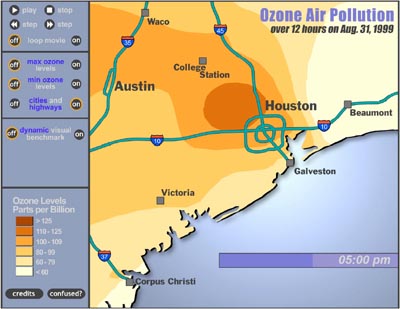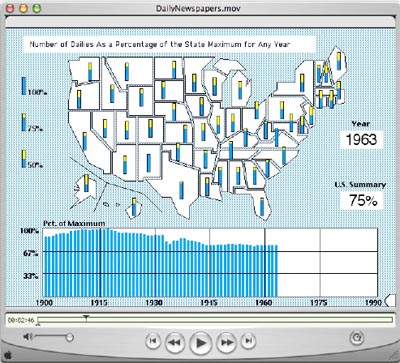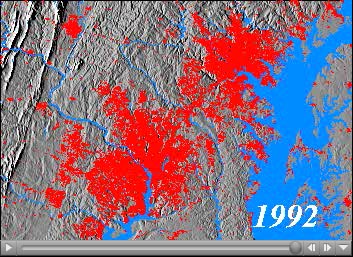1.2.4. Self Assessment
For mapmakers, animating maps presents an amplified cartographic challenge.
Animated maps are difficult and expensive to make — even with today’s powerful
software and computers. Therefore, it is always worth asking "why do I need
to animate these data? Does the animation lend something to the representation
that
would be difficult or impossible to convey in static form?" If the answer
is yes, than the added expense and time of creating an animated map may well be
justified. Cartographers who want to use animation to make a better map must know
the strengths and limitations of animation as a tool, and how map-readers are
likely
to be impacted by animation. (Harrower 2003)
Below, we present you four major challenges (disappearance, attention, complexity
and confidence) within the field of creating effective animated maps. We want
you to
think about how to solve these challenges.
Disappearance
Animated maps change, often quite dramatically from
moment to moment. As a result, there is always the potential that the map-reader
will miss important information or cues. Because of disappearance (i.e., blink
and
you miss it), many basic map reading tasks can be very difficult, such as:
estimating the size of symbols or areas, matching colours to a legend, comparing
one
symbol to another, or reading text labels. (Harrower 2003)
How would you solve this problem? Write your solutions down and
compare them with the proposed solutions below.
Solutions (Click here for more information)
Attention
The problem of where to look as the animation plays (i.e.,
attention) is a related to disappearance. Many map-readers who have limited
experience with animated maps do not know where to
look (a problem with the map) or what to
do (a problem with the interface). (Harrower 2003)
How would you solve this problem? Write your solutions
down and compare them with the proposed solutions below.
Solutions (Click here for more information)
Complexity
Many animated maps try to do too much and end up saying
very little. Burdening the user with more information than they can process in
real-time undermines the map's design and may confuse or mislead the
reader. (Harrower 2003)
How would you
solve this problem? Write your solutions down and compare them with the proposed
solutions below.
Solutions (Click here for more information)
Confidence
Users, especially children, are less confident of the
knowledge they acquire from animation than from static graphics. Since people
have
far more experience visually interpreting static graphics than animated graphics,
it
is not surprising that without equivalent experience and training, people are
less
confident with animation. (Harrower 2003)
How
would you solve this problem? Write your solutions down and compare them with
the
proposed solutions below.
Solutions (Click here for more information)
If you are interested in more information about this subject, read the article of (2003): Tips for Designing Effective Animated Maps.



